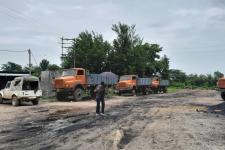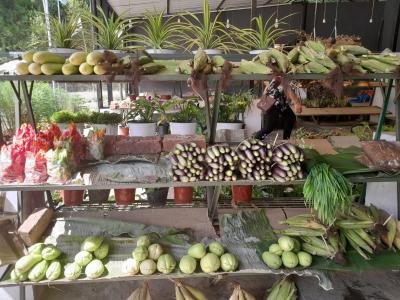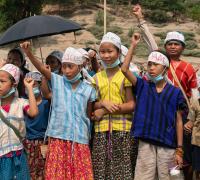More than enough: planning in plenty

In June this year, a farmer living in Wokha District, Northeast India, was weighing the long green beans he had grown painstakingly over several months of the monsoon season. We sit in his kitchen, a cemented building once made of bamboo. The family of four daughters is living in a paradigm of shifts. Over the ten years of my interactions with the family, they have grown from young children who visited a video shop to watch Kung Fu Panda, to modern android phone carrying adults who work in the city of Dimapur. Changing times have found their way into their family home situated in an otherwise rural area that contains the relics of a once industrial Naga village. The village lies on the border between Nagaland and the State of Assam where oil has historically been drilled and extracted by Indian companies (1). The industry exploited oil for several years before being asked to leave in the 1990s. However, an oil spill slowly impacts the lives of more than 138 families as of government data collected in 2011.
According to the post development thinker Arturo Escobar, the non-west presents its expertise even as it is hidden from view: it is the source of not only knowledge, but also of assimilating modern cultures in ways that allow it to flourish. In this domain of social change, new and old combine. There is no contrast between the traditional and modern, but an amalgamation via hybridisation. Thinking with Escobar, I argue that in the context of oil debates hybridization exists not only in the cultural adoption of new economic structures, but also through the emergence and disappearance of new regions of extractivism (2).
This blog is based on observations I made as part of the MyClimate project, upon revisiting the site of my own research over several years. It compiles conversations and observations made in two visits. The choice of respondents is based on who was willing to speak with me, and the deeper relationship that I have established with one family in particular. The idea is to present the story of one family as a microcosm of larger social and political dynamics.
Online and Organic
The eldest daughter speaks with pride of her father. She relates that this time her father has used YouTube to plant the green beans in rows instead of growing them in a traditional mixed cropping pattern. The kitchen is like most others in the area. Plates and glasses decorate the walls, bottles hold pork fat, bamboo shoot preserved, and the meal of the day is laid out in a customary manner across the table. Leftover rice goes to the cats and dogs. Recently, a dog was found wounded, and the younger daughter is nursing it back to health. After a few months, the long beans are now ready to be harvested, distributed among relatives in Dimapur, and sold. The new farming method recommended by YouTube worked out and the harvest is plentiful.
Across Kohima and Dimapur, farmers sit by the roadside, selling local vegetables. The piles of vegetables being sold changes every month: first stinky beans, sometimes long beans, then gourds, pumpkins, and always local bananas. Each harvest is unique because it is seasonal. However, as farmers tend to cooperate in their farming methods, the crops planted each season are common. Even then, the farmer’s effort and variety within crops is visible in the piles being sold. Some cucumbers are juicier than others, some are bigger. Differences emerge within and across species. The sale of these vegetables seems controlled too. Farmers sell for a whole number - INR 50, INR 100 - to suit the buyer. As a consumer and outsider to the region, I am excited by the piles in the markets, always looking forward to what will be available: some giant lemons, sometimes a local ginger plant, another time fragrant and small garlic pods with luscious leaves, a unique type of coriander, several bright burning Naga chilies - all becoming a part of my meals after a visit to the vegetable market of the day.

Separating the plants into bunches, my host in Wokha District puts a handful of his new crop onto a scale. One bunch after another, weighed carefully. Slowly, I realize that he is putting in just a little more than a kilo for each bunch. I stop him and suggest that he removes the extra, assuming that he was being overly generous. Why the benevolence towards strangers? He looks at me squarely and explains that each bunch of beans had an additional small number to account for the loss in weight because they would dry up with time. He is accounting for the impact of heat. Perhaps here he is practicing the counterhegemonic narrativizing of market forces? A little more and a few extra beans make up the larger gap between people who trust their farmers and those who don’t in the modern economy.
For a climate related research project, this is a revelation. The farmer is not only concerned about his crop, but also the damage to crops and customers caused by the excessive heat. Perhaps here lies the ethic of responsibility, preparing for future generations, future losses, climate impacts, and all the heavy, difficult, and impending futures? The farmer is bearing the burden of this heat, and it is entirely invisible to those buying his long beans.
This is how I slowly learn from Naga farmers and families, that is, on how to care. A farmer, a father and a family that spends their days contending with the attachment to land and agriculture, an urban rural divide, drying fields, and shifting modes of agriculture. Subsistence farming remains common. Vegetables are plentiful, land is vast, and trees are blooming even in the midst of logging, mining and other forms of extraction. There is a slow depletion of resources, but one that is thwarted by local attempts to keep the lands healthy and practice the regenerative aspect of jhum (shifting cultivation) farming. In traditional jhum farming, fields are prepared for farming by being burnt, but then after a few crops have been harvested those lands are left to grow once again.
The family’s anticipation for the vegetables drying up was a sign to prepare for eventualities, but also to do it in a way that embodied the values of generosity towards complete strangers. He wanted to make sure they had enough.
Oil and extraction
Near the family’s home in Northeast India, Nagaland, an oil spill continues unabated. Every year the oil spills further. Local people are hoping for development around this crude resource, but to them development merely means a regular water supply and electricity. While the State government has also been indicating its plans for exploration and fears of oil being siphoned off to the neighbouring state, the process of negotiation emerges as a dialogue on development that is beyond “the modern” (3). It is an autonomous process on the one hand, but one that is influenced by economic and political forces.
For instance, in 2013, the father of the family lent a piece of land to the local miners. He was given a small television in exchange, and his youngest daughter wrote down the number of each channel. Today, ten years later, his daughter faces immense struggles attaining her education. The TV plays on and the land handed over to a trader from the neighbouring region is being used to store larger piles of coal and wood.
For reasons governed by political and economic relations, and ecological concerns, the exploration of oil has not been pursued here consistently. After the oil company was asked to leave in the 1990s, attempts were made to siphon off oil. Facebook posts were shared with images of trucks that tried to steal oil. Journalists reported on the same. At times this waxing and waning is a part of the non-hegemonic forms of development. It proves to be a benefit to the community because it has meant the preservation of the forest and homes as well as the growth of new opportunities. At other times, this becomes a concern because farmers lament the lack of electricity, roads, water, and facilities. While development is a contested idea in environmental debates around the world, with even rivers gaining rights-there is room for Nagaland to define it’s own ways. Even as the State grapples with a sense of being in a so-called state of- 'underdevelopment,' there is reason to believe that it is in fact quite well developed in its own ways. It remains to be seen how the notion of development will be applied given the history of strong and well developed traditional life ways in Nagaland that both protect and depend on the forests.
In my observations, I have noticed that given the history of oil as a substance, its potential causes more commotion outside the region of its prevalence, and perhaps in the interest it generates among people. Dreams contain oil and its potentialities, but they also contain concerns and stories of loved ones, of people, connections, and networks of care. Beyond the oil as a resource is the family, the village, the connections to kin outside the village, in the cities, in the State and across the region that dictate whether it is to be pursued or not.
Even as time goes on, plants are not the only things growing here in the village. With the spill, logging, mining, depleting resources and a growing spill are emerging. Families are growing sometimes together and at other times apart. As a researcher who reconnects with the village every few years to observe the ecological damage, I realise that while lives change dramatically and subtly in ten years, the land continues to regenerate, and every time the oil is forgotten, trees and shrubs sprout out around the leaching liquid. However, the relationships within the land shift each time. When the oil is ignored, there is an atmosphere of lack, but peace. When the discussion of oil is in the news there is a palpable fear, wherein community members are not keen to visit the site of the spilling substance. While oil extraction is often equated with development, the question remains- what could be lost in an attempt to gain.
This year, a new cell phone tower is being put into the land, the water body is not shrouded in forest cover as it was ten years ago. The richest man has died, and his lands will be re-divided by the family, making dependent labour insecure about their futures. These are the stories of a little farming village of plenty.
Large and small changes all collide and bring to the complexity a negotiation. While the non-local traders are vying for resources, they also provide economic opportunities to locals who have few options of a secure livelihood and strong connections to village lands. All the development cannot undo the complexity of human life. This is what emerges even in the farmer’s choice to give the unknown buyer a few extra-long beans, a patch of land, or some of his resources for the promise of a better future, one where his daughters and family will also have more than enough.
References
1) Kikon, D. (2019). Living with Oil and Coal: Resource Politics and Militarization in Northeast India. Culture, Place, and Nature.
2) Greenhalgh, S., & Escobar, A. (1995). Encountering Development: the making and unmaking of the third world. Population and Development Review, 21(2), 430. https://doi.org/10.2307/2137509
3) Rio Discuss Oil Exploration, Mining with Centre | Nagaland Post, nagalandpost.com/index.php/rio-discuss-oil-exploration-mining-with-centre/. Accessed 28 Oct. 2023.

